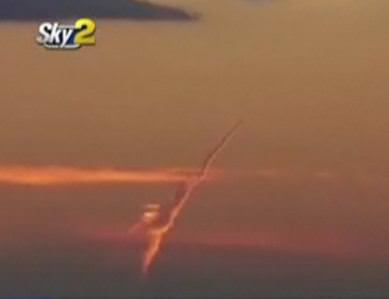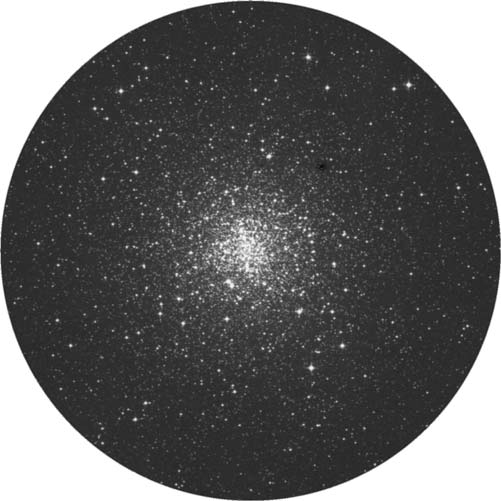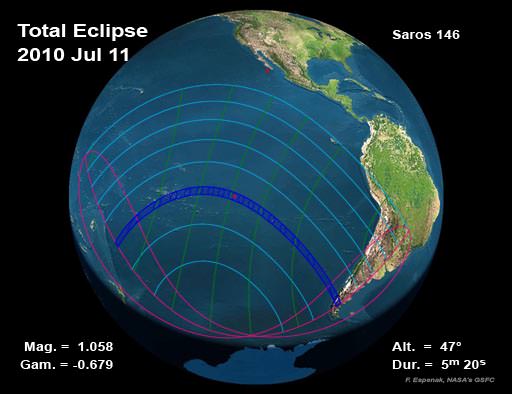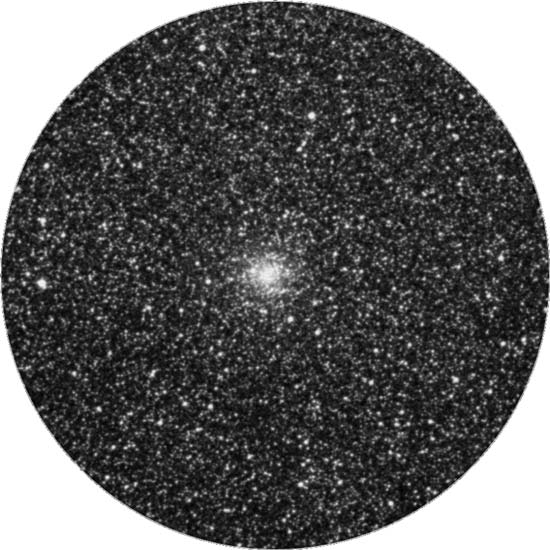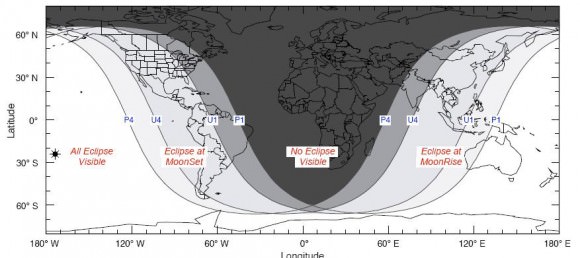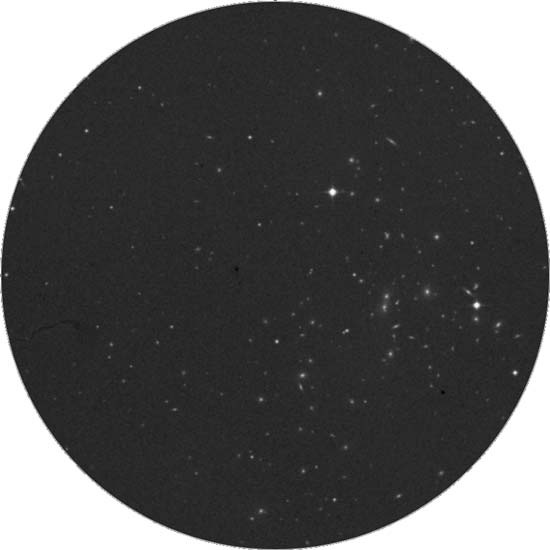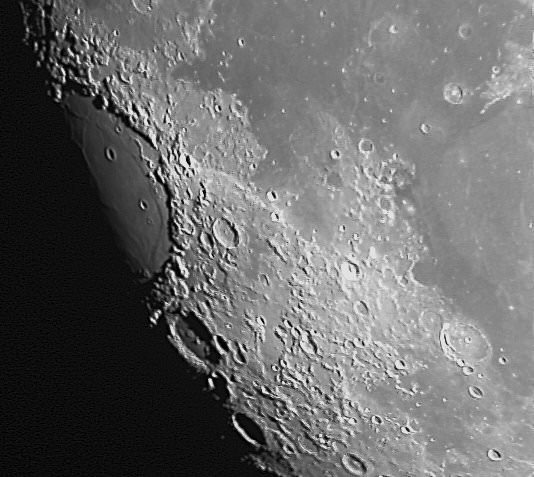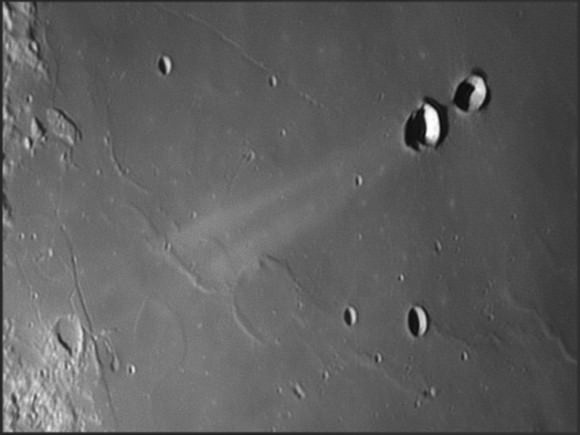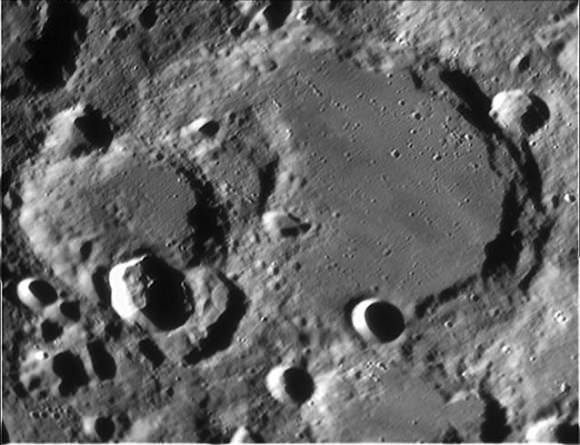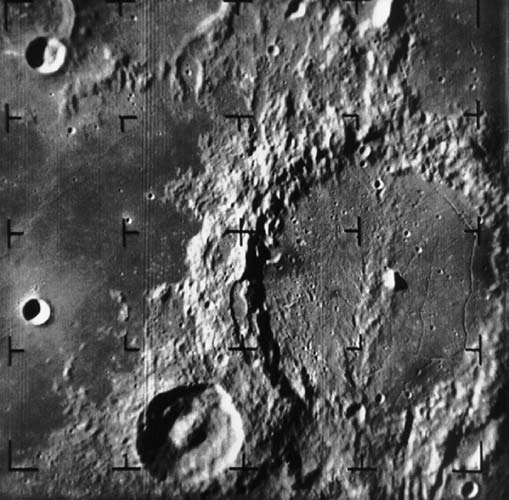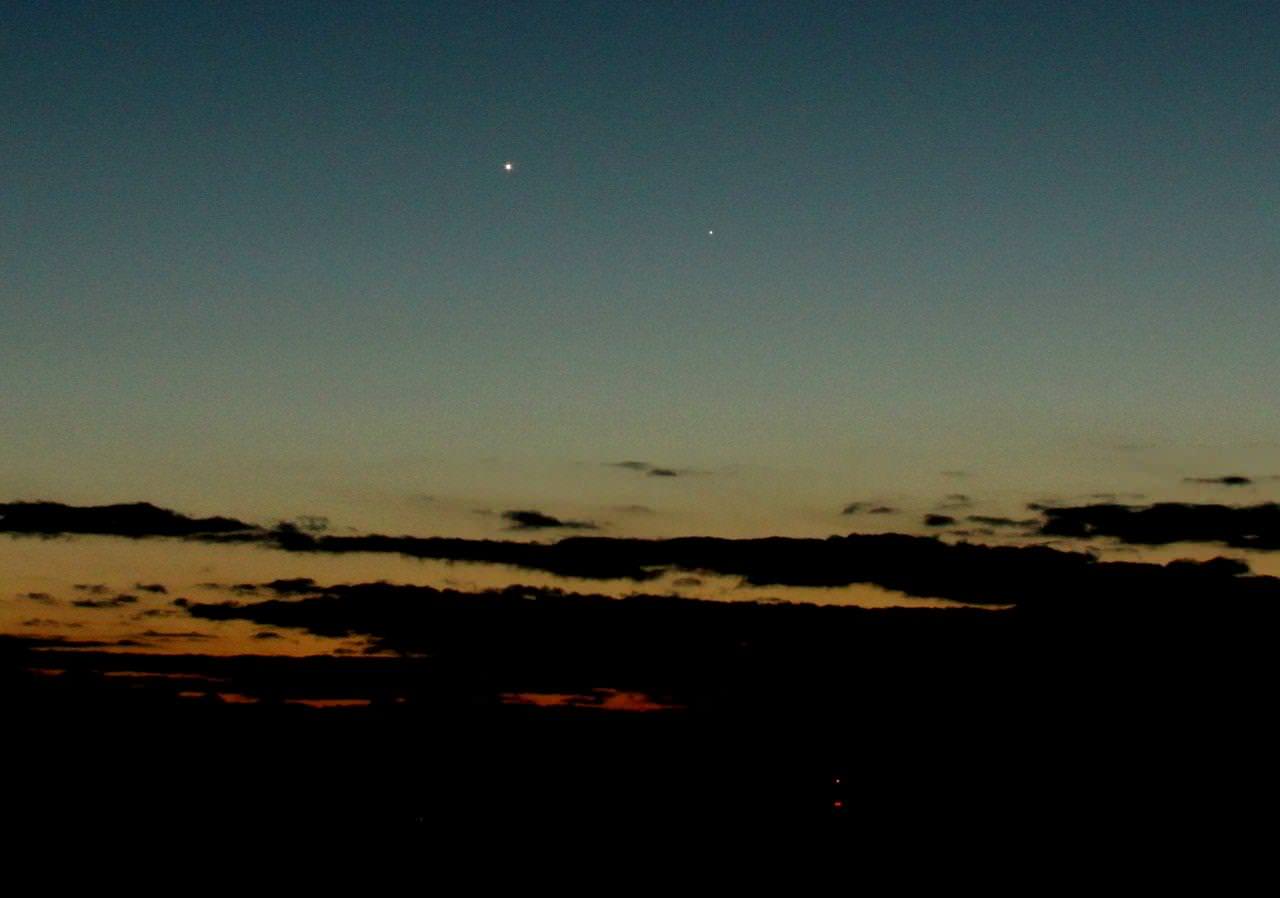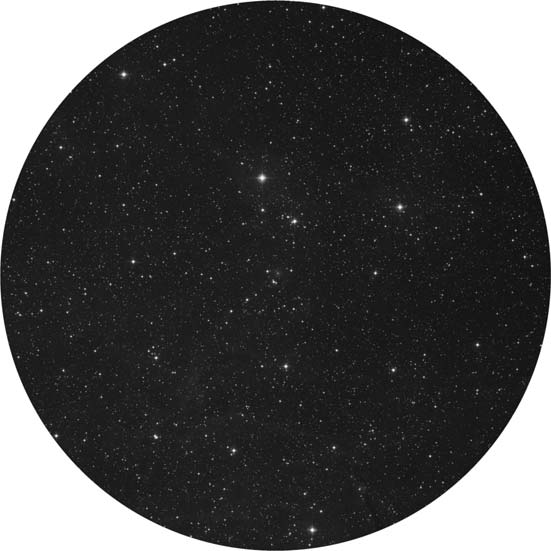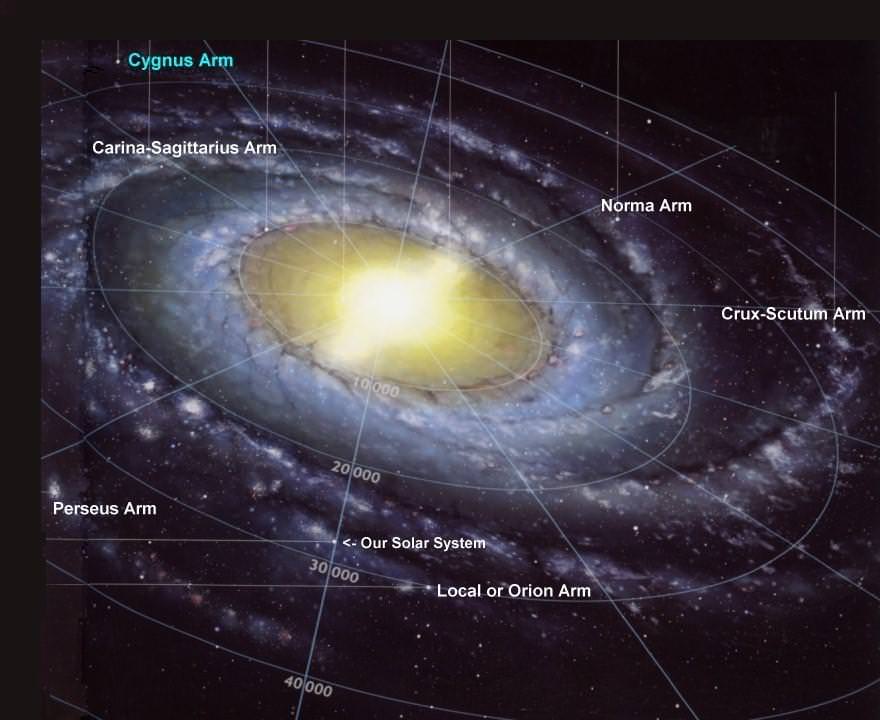NASA’s Cassini Spacecraft is doing some awesome stuff. Stay tuned to NASA’s twitter feed Space Cadets, today should be interesting. I’m Benjamin Higginbotham and this is your SpacePod for November 30th, 2010.
Continue reading “Cassini visits Enceladus – SpacePod 2010.11.30”
‘Mystery-Missile’ – Likely an Airplane
[/caption]
What took place in the skies above California’s coastline Monday, Nov. 8? That is still being hotly debated by experts and laymen alike. What appears to be a missile firing some 35 miles off the coast of California, near the Island of Catalina appears in a KCBS news chopper footage. The Pentagon has stated that it does not know what is displayed in the images. But instead of mystery, intrigue and government coverup, there is likely a more ordinary explanation: it was an optical illusion.
The Boeing Co. every so often will deploy aircraft from San Nicolas Island. These flights are part of an anti-missile laser testing program. However, the company has announced that it had nothing in the air on Monday. According to the Orange County Register, a very similar contrail was noted off of California Coast just one year earlier.
One possible explanation for the mysterious ‘plume’ is that it was the test firing of a new commercial space rocket – there has not been any confirmation of this.
While experts at Globalsecurity.org say that more than likely what is being viewed in the video is an aircraft and its contrail approaching the camera. That matches up with what scientists that have come forward have stated – that this is nothing more than the contrail made from a jetliner. In short, this whole sensation may have been caused over an optical illusion. One caused by a large aircraft, the sunset and the odd angle that the helicopter that collected the footage was shooting from.
Moreover, local radar did not pick up any fast-moving objects during the time of the ‘launch.’ In fact, in most of the footage the ‘missile’ or ‘rocket’ appears to barely move. For those that regularly follow launches only a single snippet of the video appears to show the fiery exhaust of a rocket – but this could also be the glint of sunlight off of metal.
According to the American Aerospace Defense Command, “there is no indication of any threat to our nation.” Neither NASA nor the U.S. Missile Defense Agency were quite as forthcoming, as these organizations did not immediately release information regarding the incident. Both the U.S. Air Force and Navy have stated that they were not responsible for whatever caused the vapor trail.
This is not the first time plane contrails have been mistaken for rocket launches. See the website Contrail Science for more information and to see similar previous events.
‘Star Gazer’ Jack Horkheimer dies
The host of Public Television’s “Star Gazer” show, Jack Horkheimer, died on August 20, 2010. Originally called the ‘Star Hustler,’ the program ran for 30 years and Horkheimer’s craggy voice combined with his flamboyant, show-biz style made him a unique and internationally recognized pioneer in popularizing naked-eye astronomy. Horkheimer was 72 and died of a respiratory ailment, according to a spokesman for the Miami Museum of Science and Space Transit Planetarium, where Horkheimer was the executive director for over 35 years.
Continue reading “‘Star Gazer’ Jack Horkheimer dies”
Stunning Aurora Videos
If you weren’t lucky enough to be in the right place or the right time to see any of the aurora produced by the Sun’s recent spate of activity, skywatchers around the world have started posting videos online of some really spectacular Northern Lights. Above, is the view on August 4, 2010 from Telemark, Norway. Below are more sights, also from August 4, from Latvia and Risør, Norway. These videos were posted on CitizenTube, a newsy version of YouTube.
Continue reading “Stunning Aurora Videos”
Weekend SkyWatcher’s Forecast: July 9-11, 2010
Greetings, Fellow SkyWatchers! Is it hot enough for you where you live? Not if you’re in the southern hemisphere… But this weekend the southern hemisphere is the place to be if you’re interested in catching a total solar eclipse! If you can’t travel that close, then let’s travel far, far away as we take a look at the season’s globular clusters… from easy to challenging! Be sure to keep an eye on Saturn and Mars as they draw closer together and look for bright Jupiter in the morning skies! Whenever you’re ready? Grab your optics and I’ll see you in the backyard…
July 9, 2010 – On this date in 1979, Voyager 2 quietly made its closest approach to Jupiter. How about if we take a close approach before dawn as well? Enjoy the waltz of the Galileans and all the fine details! If you enjoy watching the planets swim against the night sky, then be sure to keep an eye on the early evening visage of Saturn as Mars “back strokes” its way towards the Ring King!
Tonight let’s head on out toward two more close objects that appear differently from the rest (and each other)—same-field binocular pair M10 and M12. Located about half a fist-width west of Beta Ophiuchi, M12 (RA 16 47 14 Dec –01 56 52) is the northern most of this pair. Easily seen as two hazy round spots in binoculars, let’s go to the telescope to find out what makes M12 tick.
Since this large globular is much more loosely concentrated, smaller scopes will begin to resolve individual stars from this 24,000-light-year-distant Class IX cluster. Note that there is a slight concentration toward the core region, but for the most part the cluster appears fairly even. Large instruments will resolve out individual chains and knots of stars.
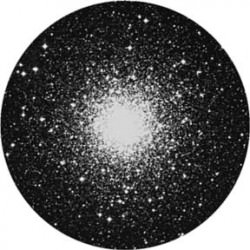 Now let’s drop about 3.5 degrees southeast and check out Class VII M10 (RA 16 57 08 Dec –04 05 57). What a difference in structure! Although they seem to be close together and similar in size, the pair is actually separated by some 2,000 light-years. M10 is a much more concentrated globular, showing a brighter core region to even the most modest of instruments. This compression of stars is what differentiates one type of globular cluster from another and is the basis of their classification. M10 appears brighter, not because of this compression but because it is about 2,000 light-years closer than M12.
Now let’s drop about 3.5 degrees southeast and check out Class VII M10 (RA 16 57 08 Dec –04 05 57). What a difference in structure! Although they seem to be close together and similar in size, the pair is actually separated by some 2,000 light-years. M10 is a much more concentrated globular, showing a brighter core region to even the most modest of instruments. This compression of stars is what differentiates one type of globular cluster from another and is the basis of their classification. M10 appears brighter, not because of this compression but because it is about 2,000 light-years closer than M12.
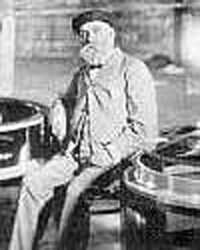 July 10, 2010 – Today we celebrate the 1832 birth on this date of Alvan Graham Clark. An astronomer himself, Clark was also a member of a famous American family of telescope makers. He helped to create the largest refractor in the world—the lenses for the 40″ Yerkes Telescope. Perhaps the stress of worrying for their safety took its toll on Alvan, for he died shortly after their first use. Tonight let’s honor Clark’s work by studying a globular cluster suitable for all optics, M4. All you have to know is Antares!
July 10, 2010 – Today we celebrate the 1832 birth on this date of Alvan Graham Clark. An astronomer himself, Clark was also a member of a famous American family of telescope makers. He helped to create the largest refractor in the world—the lenses for the 40″ Yerkes Telescope. Perhaps the stress of worrying for their safety took its toll on Alvan, for he died shortly after their first use. Tonight let’s honor Clark’s work by studying a globular cluster suitable for all optics, M4. All you have to know is Antares!
Just slightly more than a degree west (RA 16 23 35 Dec –26 31 31), this major 5th magnitude Class IX globular cluster can even be spotted unaided from a dark location. In 1746 Philippe Loys de Cheseaux happened upon this 7,200-light-year-distant beauty, one of the nearest to us. It was also included in Lacaille’s catalog as object I.9 and in Messier’s in 1764. Much to Charles’s credit, he was the first to resolve it!
As one of the loosest, or most ‘‘open,’’ globular clusters, M4 would be tremendous if we were not looking at it through a heavy cloud of interstellar dust. To binoculars, it is easy to pick out a very round, diffuse patch, yet it will begin to resolve with even a small telescope. Large telescopes will also easily see a central ‘‘bar’’ of stellar concentration across M4’s core region, which was first noted by Herschel. As an object of scientific study, in 1987, the first millisecond pulsar was discovered within M4, which turned out to be ten times faster than the Crab Nebula pulsar. Photographed by the Hubble Space Telescope in 1995, M4 was found to contain white dwarf stars—the oldest in our galaxy—with a planet orbiting one of them! A little more than twice the size of Jupiter, this planet is believed to be as old as the cluster itself. At 13 billion years, it would be three times the age of the Solar System!
July 11, 2010 – Today marks the 1732 birth on this date of Joseph Jerome Le Francais de Lalande, who determined the Moon’s parallax and published a comprehensive star catalog in 1801. While we might not be determining the Moon’s parallax against the background stars, we’re certainly going to see its effects against the background Sun! Right now the southern hemisphere is the place to be if you’re interested in catching a total solar eclipse – but this eclipse isn’t going to be an easy one to observe unless you’re on the water.
Starting roughly 2000 kilometers northeast of New Zealand at 18:15 UT, totality will begin at local sunrise over the ocean. Minutes later the shadow pass will actually cross land as it encounters the island of Mangaia for about 3 minutes total time. Totality will brush by Tahiti, encompass the uninhabited atolls of the Tuamotu Archipelago and slide its way across the mysterious Easter Island. The Moon’s shadow will take once again to the water for another 3700 kilometers where it will reach its end at the very southernmost tip of South America. For those of you who have the great fortune to eclipse chase? We wish you the very best of skies and luck!
For hard-core observers, tonight’s globular cluster study will require at least a mid-aperture telescope, because we’re staying up a bit later to go for a same-low-power-field pair—NGC 6522 (RA 18 03 34 Dec –30 02 02) and NGC 6528 (RA 18 04 49 Dec –30 03 20). You will find them easily at low power just a breath northwest of Gamma Sagittarii, better known as Al Nasl, the tip of the ‘‘teapot’s’’ spout. Once located, switch to higher power to keep the light of Gamma out of the field, and let’s do some study.
The brighter, and slightly larger, of the pair to the northeast is Class VI NGC 6522. Note its level of concentration compared to the Class V NGC 6528. Both are located around 2,000 light years away from the galactic center and are seen through a very special area of the sky known as ‘‘Baade’s Window’’—one of the few areas toward our galaxy’s core region not obscured by dark dust.
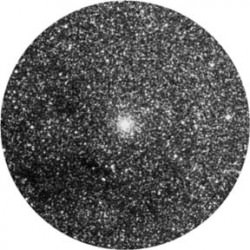 Although each is similar in concentration, distance, etc., NGC 6522 has a slight amount of resolution toward its edges, while NGC 6528 appears more random. Although both NGC 6522 and NGC 6528 were discovered by Herschel on July 24, 1784, and both are the same distance from the galactic core, they are very different. NGC 6522 has an intermediate metallicity. At its core, the red giants have been depleted, or stripped tidally by evolving into blue stragglers. It is possible that core collapse has already occurred. NGC 6528, however, contains one of the highest metal contents of any known globular cluster collected in its bulging core!
Although each is similar in concentration, distance, etc., NGC 6522 has a slight amount of resolution toward its edges, while NGC 6528 appears more random. Although both NGC 6522 and NGC 6528 were discovered by Herschel on July 24, 1784, and both are the same distance from the galactic core, they are very different. NGC 6522 has an intermediate metallicity. At its core, the red giants have been depleted, or stripped tidally by evolving into blue stragglers. It is possible that core collapse has already occurred. NGC 6528, however, contains one of the highest metal contents of any known globular cluster collected in its bulging core!
Until next time? Keep reaching for the stars!
This week’s awesome images are: M10, M12, M4, NGC 6522 and NGC 6528 from Palomar Observatory, courtesy of Caltech. Alvan Clark historical image and eclipse information courtesy of NASA. We thank you so much!
Weekend SkyWatcher’s Forecast: June 25-27, 2010
Greetings, fellow SkyWatchers! If we can keep the clouds and rain away, this will be an incredible weekend to enjoy some peaceful and relaxing time under the Moon and stars. We’ll begin with a heads up on a partial lunar eclipse whose beginning – or end – will be visible to most of us. Check your times carefully, because this one crosses the international date line! While you’re out, take a look at the lunar surface for some very interesting craters – or just relax with binoculars and suck in the photons of some curious variable stars. Are you ready? Then I’ll see you in the back yard…
June 25, 2010 – Today celebrates the birth of Hermann Oberth. Born in 1894 on this date, Oberth is considered to be the father of modern rocketry and space travel. But you won’t need a rocket to travel skyward as we gear up for the 2010 partial lunar eclipse!
A major section of western North and South America is in for treat as they will be able to see the beginning stages. These areas include Western Brazil, western Venezuela, and South American countries west of these locations. Believe it or not, a section of the southeastern United States will even be able to witness the eclipse – if it’s not raining!
The dividing line runs through the state of Georgia following a diagonal path north to Minnesota. States west of this line will also be within range of seeing the entire event until sunrise. On the west coast of the United States, the Moon will slide into umbral eclipse at 3:16 a.m. PDT, be deepest in shadow at 4:38 a.m. PDT, and the eclipse ends at 6:00 a.m. PDT – right about dawn. Locations that will be able to see the entire partial eclipse include the Pacific islands such as Hawaii, Polynesia, Fiji, Marshall Islands, New Zealand, Papua New Guinea, Australia, and most of Japan and the Philippines. Regions such as eastern China, the east edge of the USSR, Indonesia and the Thailand area will be able to see the very end of the 2010 partial lunar eclipse.
Despite bright skies tonight, take out your binoculars and look for a circlet of seven stars that reside about halfway between orange Arcturus and brilliant blue-white Vega. This quiet constellation is named Corona Borealis, or the Northern Crown.
Just northwest of its brightest star is a huge concentration of over 400 galaxies that reside over a billion light-years away from us. Known as Abell 4065, the Corona Borealis Galaxy Cluster is an area so small in apparent size that from our point of view we could eclipse it with a small coin held at arm’s length!
 June 26, 2010 – Happy Birthday, Charles Messier! Born in 1730 on this date, almost everyone recognizes the name of this French astronomer who discovered 15 comets. He was the first to compile a systematic catalog – the ‘‘M objects.’’ The Messier Catalogue (1784) contains 103 star clusters, nebulae, and galaxies. But did you know Lyman Spitzer, Jr, shared this birthday? Born in 1914, Spitzer advanced our knowledge of physical processes in interstellar space and pioneered efforts to harness nuclear fusion as a clean energy source. He studied star-forming regions and suggested that the brightest stars in spiral galaxies formed recently. Not only that, but Spitzer was the first person to propose placing a large telescope in space, and so launched the development of the Hubble Space Telescope!
June 26, 2010 – Happy Birthday, Charles Messier! Born in 1730 on this date, almost everyone recognizes the name of this French astronomer who discovered 15 comets. He was the first to compile a systematic catalog – the ‘‘M objects.’’ The Messier Catalogue (1784) contains 103 star clusters, nebulae, and galaxies. But did you know Lyman Spitzer, Jr, shared this birthday? Born in 1914, Spitzer advanced our knowledge of physical processes in interstellar space and pioneered efforts to harness nuclear fusion as a clean energy source. He studied star-forming regions and suggested that the brightest stars in spiral galaxies formed recently. Not only that, but Spitzer was the first person to propose placing a large telescope in space, and so launched the development of the Hubble Space Telescope!
Tonight the mighty Moon will still rule the sky, providing a wonderful opportunity for casual inspection. Why not grab a telescope and view the lunar surface for a couple of telescopic challenges that are easy to catch? All you have to know is Mare Crisium!
On the southeastern shoreline is a peninsula that reaches into Crisium’s dark basin. This is Promontorium Agarum. On the western shore, bright Proclus lights the banks, but look into the interior for the two dark pockmarks of Pierce to the north and Picard to the south. Be sure to mark them on your notes!
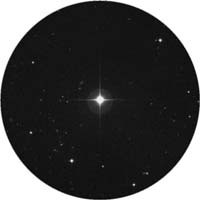 When you’re finished, point your binoculars or telescopes back toward Corona Borealis and about three finger-widths northwest of Alpha for variable star R (RA 15 48 35 Dec +28 09 24). This star is a total enigma. Discovered in 1795, most of the time R carries a magnitude near 6 but can drop to magnitude 14 in a matter of weeks – only to unexpectedly brighten again! It is believed that R emits a carbon cloud, which blocks its light. Oddly enough, scientists can’t even accurately determine the distance to this star! When studied at minimum, the light curve resembles a ‘‘reverse nova’’ and has a peculiar spectrum. It is very possible that this ancient Population II star has used all of its hydrogen fuel and is now fusing helium to form carbon.
When you’re finished, point your binoculars or telescopes back toward Corona Borealis and about three finger-widths northwest of Alpha for variable star R (RA 15 48 35 Dec +28 09 24). This star is a total enigma. Discovered in 1795, most of the time R carries a magnitude near 6 but can drop to magnitude 14 in a matter of weeks – only to unexpectedly brighten again! It is believed that R emits a carbon cloud, which blocks its light. Oddly enough, scientists can’t even accurately determine the distance to this star! When studied at minimum, the light curve resembles a ‘‘reverse nova’’ and has a peculiar spectrum. It is very possible that this ancient Population II star has used all of its hydrogen fuel and is now fusing helium to form carbon.
July 27, 2010 – Tonight we’ll again honor the June 26 birth of Charles Messier by heading toward the lunar surface first, in order to pick off another study object on our list – the twin crater pair Messier and Messier A.
Located in Mare Fecunditatis about a third of its width from west to east, these two craters will be difficult to find in binoculars, but not hard for even a small telescope and intermediate power. Indeed named for the famed French astronomer, the easternmost crater is somewhat oval in shape, with dimensions of 9 by 11 kilometers. At high power, Messier A to the west appears to have overlapped a smaller crater during its formation; and it is slightly larger at 11 by 13 kilometers. Although it is not on the challenge list, you’ll find another point of interest to the northwest. Rima Messier is a long surface crack, which runs diagonally across Mare Fecunditatis’s northwestern flank and reaches a length of 100 kilometers.
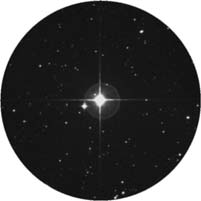 For variable star fans, let’s return to and focus our attention on S Coronae Borealis, located just west of Theta and the westernmost star in the constellation’s arc formation (RA 15 21 23 Dec +31 22 02). At magnitude 5.3, this long-term variable takes almost a year to go through its changes – usually far outshining the 7th magnitude star to its northeast – but will drop to a barely visible magnitude 14 at minimum. Compare it to the eclipsing binary U Coronae Borealis about a degree northwest. In slightly over 3 days, this Algol-type will range by a full magnitude as its companions draw together.
For variable star fans, let’s return to and focus our attention on S Coronae Borealis, located just west of Theta and the westernmost star in the constellation’s arc formation (RA 15 21 23 Dec +31 22 02). At magnitude 5.3, this long-term variable takes almost a year to go through its changes – usually far outshining the 7th magnitude star to its northeast – but will drop to a barely visible magnitude 14 at minimum. Compare it to the eclipsing binary U Coronae Borealis about a degree northwest. In slightly over 3 days, this Algol-type will range by a full magnitude as its companions draw together.
Until next week? Wishing you clear skies!
This article’s awesome illustrations are: Eclipse Chart courtesy of NASA, Abell 4065, R CorBor and S CorBor from Palomar Observatory, courtesy of Caltech, Lyman Spitzer historical image, Crisium in Decline courtesy of Shevill Mathers and Messier craters by Damien Peach. We thank you so much!
Weekend SkyWatcher’s Forecast – June 18-20, 2010
Greetings, fellow Stargazers! Have you been enjoying the rain? Then keep your eyes open for a “celestial shower” as meteoritic activity picks up over the next few nights, culminating in the peak of the Ophiuchid meteor Saturday night through Sunday morning. While you’re out relaxing, be sure to spare some time for lunacy and take a look some interesting features on the Moon. Need a test of your telescope’s resolving power? Then I “double dare” you to take on Gamma Virginis! Whenever you’re ready, I’ll see you in the back yard….
 Friday, June 18, 2010 – Let’s begin the day by recognizing the 1799 birth on this date of William Lassell, telescope maker and discoverer of Triton (a moon of Neptune), and Ariel and Umbriel (satellites of Uranus). As often happens, great astronomers share birth dates, and this time it’s 187 years later for Allan Rex Sandage. A Bruce Medalist, Dr. Sandage is best known for his 1960 optical identification of a quasar, with his junior colleague, Thomas Matthews.
Friday, June 18, 2010 – Let’s begin the day by recognizing the 1799 birth on this date of William Lassell, telescope maker and discoverer of Triton (a moon of Neptune), and Ariel and Umbriel (satellites of Uranus). As often happens, great astronomers share birth dates, and this time it’s 187 years later for Allan Rex Sandage. A Bruce Medalist, Dr. Sandage is best known for his 1960 optical identification of a quasar, with his junior colleague, Thomas Matthews.
Our telescope lunar challenge tonight will be Hadley Rille. Find Mare Serenitatis and look for the break along its western shoreline that divides the Caucasus and Apennine mountain ranges. South of this break is the bright peak of Mons Hadley, which is of great interest for several reasons, so power up as much as possible.
Impressive Mons Hadley measures about 24 by 48 kilometers at its base and reaches up an incredible 4,572 meters. If volcanic activity had created it, Mons Hadley would be comparable to some of the very highest volcanically formed peaks on Earth, like Mount Shasta and Mount Rainer. South is the secondary peak, Mons Hadley Delta. It is home to the Apollo 15 landing site just a breath north of where it extends into the cove created by Palus Putredinus. Along this ridge line and smooth floor, look for a major fault line, winding its way across 120 kilometers of lunar surface; this is Hadley Rille. In places, the Rille spans 1,500 meters in width and drops to a depth of 300 meters below the surface. Believed to have been formed by volcanic activity 3.3 billion years ago, we can see the impact lower gravity has on this type of formation. Earthly lava channels are usually less than 10 kilometers long, and only around 100 meters wide. During the Apollo 15 mission, Hadley Rille was visited at a point where it was only 1.6 kilometers wide, still a considerable distance. Over a period of time, the Rille’s lava may have continued to flow through this area, yet it remains forever buried beneath years of regolith.
Saturday, June 19, 2010 – Tonight on the Moon we’ll be looking for another challenging feature and the craters that conjoin it—Stofler and Faraday. Located along the terminator to the south, crater Stofler was named for Dutch mathematician and astronomer Johan Stofler.
Consuming lunar landscape with an immense diameter of 126 kilometers, and dropping 2,760 meters below the surface, Stofler is a wonderland of small details in an eroded surrounding. Breaking its wall on the north is Fernelius, but sharing the southeastern boundary is Faraday. Named for English physicist and chemist Michael Faraday, this crater is more complex and deeper (4,090 meters) but far smaller in diameter (70 kilometers). Look for myriad smaller strikes that bind the two together!
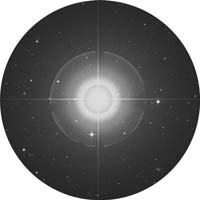 When you’re done, let’s have a look at a delightful pair—Gamma Virginis (RA 12 41 41 Dec +01 26 54). Better knownas Porrima , this is one cool binary whose components are of almost equal spectral type and brightness. Discovered by Bradley and Pound in 1718, John Herschel was the first to predict this pair’s orbit in 1833, and stated that one day they would become inseparable to all but the very largest of telescopes—and he was right. In 1920 the A and B stars had reached their maximum separation, and during 2007 they were as close together as they ever can be. Observed as a single star in 1836 by William Herschel, its 171-year orbit puts Porrima in almost the same position now as it was when Sir William saw it!
When you’re done, let’s have a look at a delightful pair—Gamma Virginis (RA 12 41 41 Dec +01 26 54). Better knownas Porrima , this is one cool binary whose components are of almost equal spectral type and brightness. Discovered by Bradley and Pound in 1718, John Herschel was the first to predict this pair’s orbit in 1833, and stated that one day they would become inseparable to all but the very largest of telescopes—and he was right. In 1920 the A and B stars had reached their maximum separation, and during 2007 they were as close together as they ever can be. Observed as a single star in 1836 by William Herschel, its 171-year orbit puts Porrima in almost the same position now as it was when Sir William saw it!
 Sunday, June 20, 2010 – In the predawn hours, we welcome the ‘‘shooting stars’’ as we pass through another portion of the Ophiuchid meteor stream. The radiant for this pass lies nearer Sagittarius, and the fall rate varies from 8 to 20 per hour, but the Ophiuchids can sometimes produce more than expected! Perhaps the sky acknowledges the 1966 passing of Georges Lemaitre on this date? Lemaitre researched cosmic rays and the three-body problem and in 1927 formulated the Big Bang theory using Einstein’s theories.
Sunday, June 20, 2010 – In the predawn hours, we welcome the ‘‘shooting stars’’ as we pass through another portion of the Ophiuchid meteor stream. The radiant for this pass lies nearer Sagittarius, and the fall rate varies from 8 to 20 per hour, but the Ophiuchids can sometimes produce more than expected! Perhaps the sky acknowledges the 1966 passing of Georges Lemaitre on this date? Lemaitre researched cosmic rays and the three-body problem and in 1927 formulated the Big Bang theory using Einstein’s theories.
Are you ready to explore some more history? Then tonight have a look at the Moon and identify Alphonsus; it’s the centermost in a line of rings and looks much like the Theophilus, Cyrillus, and Catharina trio.
Alphonsus is a very old Class V crater, spans 118 kilometers in diameter, drops below the surface to about 2,730 meters, and contains a small central peak. Eugene Shoemaker had studied this partially flooded crater and found dark haloes on the floor. Again, this could be attributed to volcanism. Shoemaker believed they were maar volcanoes, and the haloes were dark ash. Power up and look closely at the central peak, for not only did Ranger 9 hard land just northeast, but this is the only area on the Moon where an astronomer has observed a change and backed up that observation with photographic proof.
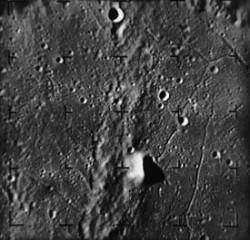 On November 2, 1958, Nikolai Kozyrev long and arduous study of Alphonsus was about to be rewarded. Some two years earlier Dinsmore Alter had taken a series of photographs from the Mt. Wilson 60’’ reflector that showed hazy patches in this area that could not be accounted for. Night after night, Kozyrev continued to study at the Crimean Observatory, but with no success. During the process of guiding the scope for a spectrogram, the unbelievable happened—a cloud of gaseous molecules containing carbon had been captured! Selected as the last target for the Ranger series of photographic missions, Ranger 9 delivered 5,814 spectacular high-resolution images of this mysterious region before it crashed nearby. Capture it yourself tonight!
On November 2, 1958, Nikolai Kozyrev long and arduous study of Alphonsus was about to be rewarded. Some two years earlier Dinsmore Alter had taken a series of photographs from the Mt. Wilson 60’’ reflector that showed hazy patches in this area that could not be accounted for. Night after night, Kozyrev continued to study at the Crimean Observatory, but with no success. During the process of guiding the scope for a spectrogram, the unbelievable happened—a cloud of gaseous molecules containing carbon had been captured! Selected as the last target for the Ranger series of photographic missions, Ranger 9 delivered 5,814 spectacular high-resolution images of this mysterious region before it crashed nearby. Capture it yourself tonight!
Until next time? Ask for the Moon… But keep on reaching for the stars!
This week’s awesome images are (in order of appearance): Dr. Alan Sandage courtesy of Dr. Sandage, Hadley Rille, courtesy of Wes Higgins, Stoffler and Faraday courtesy of Wes Higgins, Porrima – Palomar Observatory courtesy of Caltech, Georges Lemaitre and Albert Einstein (historical image), Ranger 9 Image of Alphonsus taken 3 minutes before impact courtesy of NASA, Alphonsus’ central peak taken 54 seconds before Ranger 9 impact courtesy of NASA. We thank you so much!
Planet Dance…
Have you been watching the conjunction of Venus and Mercury? Right now the inner planets are putting on quite a show just after sunset…
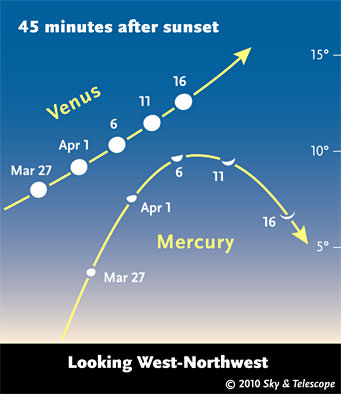 If you missed Mercury at its closest to Venus and brightest this weekend, don’t worry. The pair will still be mixing it up in the twilight sky through April 12. What will really be fun is watching the orbital path over the next week. Thanks to Sky & Telescope Magazine, you’ve got a wonderful diagram to help you see visualize the orientation. Don’t give up if you don’t spot Mercury right away, because even the slightest amount of sky haze can conceal it. Instead, try using binoculars to assist you… and use a telescope to pick out the phases of both planets!
If you missed Mercury at its closest to Venus and brightest this weekend, don’t worry. The pair will still be mixing it up in the twilight sky through April 12. What will really be fun is watching the orbital path over the next week. Thanks to Sky & Telescope Magazine, you’ve got a wonderful diagram to help you see visualize the orientation. Don’t give up if you don’t spot Mercury right away, because even the slightest amount of sky haze can conceal it. Instead, try using binoculars to assist you… and use a telescope to pick out the phases of both planets!
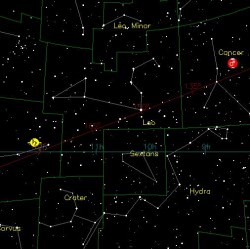 And don’t forget… There is more than one planetary pair dancing right now, too! As the skies darken, be sure to look higher overhead as Mars and Saturn take their posts at either end of Leo the Lion. It’s a spectacular evening showing that doesn’t even require a telescope!
And don’t forget… There is more than one planetary pair dancing right now, too! As the skies darken, be sure to look higher overhead as Mars and Saturn take their posts at either end of Leo the Lion. It’s a spectacular evening showing that doesn’t even require a telescope!
Enjoy….
Many thanks to Mike Romine for the conjunction photo and to Sky and Telescope for the planetary diagram.
Weekend SkyWatcher’s Forecast: March 12-14, 2010
Greetings, fellow SkyWatchers! If you’re a die-hard amateur astronomer, then you’ll recognize this as one of the prime times to undergo the rigorous “Messier Marathon” – an all night race to see how many Messier objects you can capture! If you need a bit of assistance, be sure to visit the Guide To Space section of Universe Today where you’ll find plenty of information to help you along with your quest. If you’re into a more quiet weekend, then come along as we discover some galactic star clusters that are a little bit more off the beaten path. Whenever you’re ready, I’ll see you in the backyard…
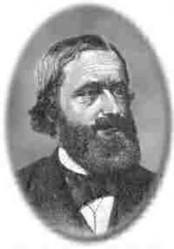 March 12, 2010 – Today let’s celebrate three births! First comes Simon Newcomb. Born on this date in 1835, Newcomb was a Canadian–American astronomer who was really good with numbers. We have him to thank for ephemerides, those great tables of computed places of celestial bodies over long periods of time. Next is 1824 and Gustav Robert Kirchhoff, a physicist who established the theory of spectral analysis. Kirchhoff’s rule states: ‘‘When light passes through a gas, the gas absorbs the wavelengths it would emit if heated.’’ Kirchhoff was very knowledgeable in the field of electricity as well. In 1845, he proved current would flow at the speed of light in a zero resistance conductor. Last is Dorrit Hoffleit (b. 1906), the author of the Yale Bright Star Catalog. Dorrit enjoyed an 80-year career in astronomy and was one of the last living links to Annie Jump Cannon and the senior women’s astrophysics team at Harvard. In her 100-year life, Hoffleit certainly saw a lot of advances in astronomy!
March 12, 2010 – Today let’s celebrate three births! First comes Simon Newcomb. Born on this date in 1835, Newcomb was a Canadian–American astronomer who was really good with numbers. We have him to thank for ephemerides, those great tables of computed places of celestial bodies over long periods of time. Next is 1824 and Gustav Robert Kirchhoff, a physicist who established the theory of spectral analysis. Kirchhoff’s rule states: ‘‘When light passes through a gas, the gas absorbs the wavelengths it would emit if heated.’’ Kirchhoff was very knowledgeable in the field of electricity as well. In 1845, he proved current would flow at the speed of light in a zero resistance conductor. Last is Dorrit Hoffleit (b. 1906), the author of the Yale Bright Star Catalog. Dorrit enjoyed an 80-year career in astronomy and was one of the last living links to Annie Jump Cannon and the senior women’s astrophysics team at Harvard. In her 100-year life, Hoffleit certainly saw a lot of advances in astronomy!
While this is traditionally a “Messier Marathon Weekend”, tonight we’ll break with tradition and locate 6 Canis Minoris about three finger-widths northwest of Procyon. This normal K-type orange giant is around 560 light-years away from Earth, but aim a telescope its way for an opportunity to study an overlooked open cluster—Dolidze 26 (RA 07 30 06 Dec +11 54 00).
In the eyepiece, you’ll find a faint collection of stars that aren’t related to 6 Canis Minoris. Clusters of this type aren’t highly studied yet, but they belong to a group near in age and population and sharing similar star formation processes. Unlike other open clusters, these odd collections contain peculiar stars that produce very high velocity stellar winds and steady X-ray emission. Although it might not be as splashy as a Messier object, Dolidze 26 may very well accelerate cosmic ray particles!
March 13, 2010 – Today note the 1886 birth of Albert William Stevens, a daring balloonist who took the Explorer II to an altitude of 72,395 feet. He took the first photo showing Earth’s curvature and the first solar eclipse photo of the Moon’s shadow on Earth. Also, salute the 1855 birth on this date of Percival Lowell, who predicted the existence of Pluto (but Clyde Tombaugh was the one who actually discovered it, on Lowell’s 75th birthday!). Sir Percival was a determined soul who spent his life trying to find proof of life on Mars. He founded Lowell Observatory in 1894, where he studied Mars intensively, drawing the Red Planet covered with canals and oases. As Lowell once said: ‘‘Imagination is as vital to any advance in science as learning and precision are essential for starting points.’’
Tonight we’ll look at a bright collection of stars located less than a handspan west of Procyon. Its name is Collinder 106 (RA 06 37 19 Dec +05 57 55).
At a combined magnitude of 4.5, this expansive open cluster can be spotted as a hazy patch with the unaided eye and comes to full resolution with binoculars. It contains only around 14 members, but this widely scattered galactic collection has helped scientists determine size scales and dispersion among groups of its type. Viewed telescopically at low power, the observer will find it rich in background stars and a true delight in a low power, wide field eyepiece. If you’d like a challenge, hop a half degree to the northeast to spot Collinder 111 (RA 06 38 42 Dec +06 54 00). While visually only about one-tenth the apparent size of its larger southwestern neighbor, spare little Collinder 111 also belongs to the same class of open clusters. Who knows what may lurk around these understudied clusters?
March 14, 2010 – Celebrate today’s famous astro births, starting with astronaut Frank Borman (b. 1928), a crew member of Apollo 8, the first manned flight around the Moon. Next, astronaut Eugene Cernan (b. 1934), who floated in space for more than 2 hours during the Gemini 9 mission and piloted Apollo 10. How about Giovanni Schiaparelli (1835), the Italian astronomer who described Mars’s ‘‘canali’’ and named its ‘‘seas’’ and ‘‘continents.’’ Schiaparelli’s comet studies demonstrated that meteoroid swarms existed in the path of cometary orbits, and thus predicted annual meteor showers. He was first to suggest that Mercury and Venus rotate and discovered the asteroid Hesperia. Still not enough? Then wish a happy birthday to Albert Einstein (b. 1879), the German–American physicist considered the most brilliant intellect in human history!
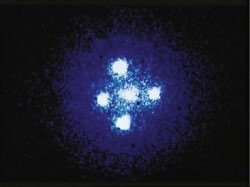 For a moment let’s reflect on Einstein’s Cross, proof of his genius. We can’t observe this Pegasus based gravitational lens right now, but we can try to understand Einstein’s theory of gravity as an effect of the curvature in space–time. For example, if you draw a line around the center of a ball, the line would be straight, eventually coming back to its point of origin. We don’t see the point until we reach it, but we know it’s there. Einstein knew this dimension existed and predicted any object with mass will bend space and time around it, just like our line around the ball. He predicted light would also follow a curved path around an object. . .such as a distant quasar located behind a closer galaxy!
For a moment let’s reflect on Einstein’s Cross, proof of his genius. We can’t observe this Pegasus based gravitational lens right now, but we can try to understand Einstein’s theory of gravity as an effect of the curvature in space–time. For example, if you draw a line around the center of a ball, the line would be straight, eventually coming back to its point of origin. We don’t see the point until we reach it, but we know it’s there. Einstein knew this dimension existed and predicted any object with mass will bend space and time around it, just like our line around the ball. He predicted light would also follow a curved path around an object. . .such as a distant quasar located behind a closer galaxy!
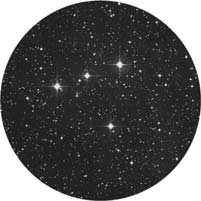 Tonight’s object is a ‘‘cross’’ of stars that we’ll dub “Einstein’s Asterism”. Begin at Procyon and shift about 10 degrees southwest (or 2 degrees south of 18 Monocerotis) to locate this pretty grouping of stars. Yes it’s true. It’s just an unknown, undocumented, and unnamed asterism, but how fitting to honor all these famous astro figures and a brilliant man who once said: ‘‘The fairest thing in life we can experience is the mysterious. It. . .stands at the cradle of true art and true science.’’
Tonight’s object is a ‘‘cross’’ of stars that we’ll dub “Einstein’s Asterism”. Begin at Procyon and shift about 10 degrees southwest (or 2 degrees south of 18 Monocerotis) to locate this pretty grouping of stars. Yes it’s true. It’s just an unknown, undocumented, and unnamed asterism, but how fitting to honor all these famous astro figures and a brilliant man who once said: ‘‘The fairest thing in life we can experience is the mysterious. It. . .stands at the cradle of true art and true science.’’
Until next week, best of luck and clear skies to our marathoning friends!
This week’s awesome images are a historical collection of famous astronomers, “Einstein’s Cross” as imaged by the HST and provided by NASA, and all the great cluster images as done by Palomar Observatory, courtesy of Caltech. We thank you so much!
Astronomy Without A Telescope – Don’t Make a Meal of It
You should always put out the old dinner set when you have astronomers around. It all starts innocently enough with imagine this wineglass is the Earth rotating on its axis… But then someone decides that large plate is just right to show the orientation of an orbital plane and more wine glasses are brought to bear to test a solution to the three body problem and…
My favorite dinner set demonstration is to use the whole table to represent the galactic plane – ideally with an upturned wide rimmed soup bowl in the middle to mimic the galactic hub. Then you get a plate to represent the solar system’s orbital plane and hold it roughly facing the galactic hub, but at a 63 degree angle from the horizontal. We know the equatorial plane of the Milky Way is tilted 63 degrees from the ecliptic – or vice versa since here we are arbitrarily making the galactic plane (table) the horizontal. This means galactic north is up towards the ceiling – and incidentally a line drawn north up from the galaxy’s centre (i.e. the galactic axis) passes fairly close to Arcturus.
Now for the Earth. Wine glasses make an excellent Earth model since the stem can represent the Earth’s axis of rotation. The glass is at least a bit round and you can see through it for a view of what someone would see from the surface of that glass.
Looking down on the solar system (plate) from its north, which is orientated away from the galactic hub (table), it actually rotates anti-clockwise. So if you hold the glass at the top of the plate – that’s Earth at about September, then move it to the left for December, down to the bottom for March, right side for June and back to September.
So, holding your plate at 63 degrees to the table, now hold the wine glass tilted at 23.5 degrees to the plate. Assuming you left your protractor at home – this will mean the wine glass stem is now almost parallel to the table – since 63 + 23.5 is close to 90 degrees. In other words, the Earth’s axis is almost perpendicular to the galactic axis.
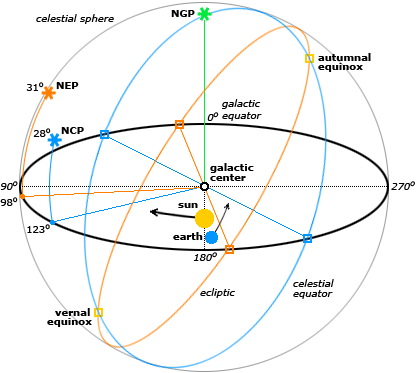
You should really imagine the plate being embedded within the table, since you will always see some part of the Milky Way at night throughout the year. But, in any case, the wine glass gives a good demonstration of why we southerners get such a splendid view of the galactic hub in Sagittarius. It’s hidden in the daytime around March – but come September about 7pm you get the Milky Way running almost north-south across the sky with Sagittarius almost directly overhead. Arcturus is visible just above the western horizon, being about where the galaxy’s northern axis points (that is, the ceiling above the middle of the table).
And if you look to the north you can see Vega just above the horizon – which is more or less the direction the solar system (plate) is heading in its clockwise orbit around the galaxy (table).
Now, what’s really interesting is if I add the Moon in by just, oh… Er, sorry – that wasn’t new was it?

